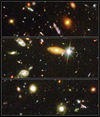When you look up to the night sky and see "the stars", many of these points of light turn out to be two or more stars, small clusters of stars, galaxies and even clusters of galaxies. The brightness of a star as seen from Earth does not indicate its closeness. It may be close or far away, as a galaxy far away can seem as bright as a small nearby star.
Not are stars that appear in the same section of the sky are necessarily close to each other. Since man first looked towards the night sky, patterns of stars have been imagined and named. The signs of the zodiac and the Southern Cross are two examples. These patterns are called 'constellations' and although they can help us with navigation and star finding, they are not real groupings of stars in an astronomical sense.
Binary star and other small star systems
 Single stars like our Sun might even be a minority, as many "stars"
turn out to be "binary stars" or two stars rotating around each
other. Alpha Centauri is a binary star system and a single star all rotating
around each other. These sets of stars could have their own Solar System
centred on a pair of stars instead of only one. Can you imagine dawn with
two suns rising?
Single stars like our Sun might even be a minority, as many "stars"
turn out to be "binary stars" or two stars rotating around each
other. Alpha Centauri is a binary star system and a single star all rotating
around each other. These sets of stars could have their own Solar System
centred on a pair of stars instead of only one. Can you imagine dawn with
two suns rising?
Star clusters
The Pleiades, or seven sisters, to the North West of Orion and near
the Milky Way are a nearby cluster of not seven, but about 120 stars.
These stars appear in the same part of the sky, but they are all near
each other in a small group. Thus, they may have a name like a constellation,
but they are a true group of stars.
Galaxies
 Galaxies are much larger groups of stars, which seem to have their own
internal organisation. Many galaxies like our own, the Milky Way being
but part of one arm of stars, appear in telescopes as large wheels with
spiralling spokes of stars. These are known as 'spiral galaxies'. Other
galaxies are less well organised, but all have some structure in the way
their member stars are arranged in space. It is now believed that at the
centre of our own galaxy and probably at the centre of all galaxies lies
a giant "Black Hole". This "Black Hole" sucks in nearby
stars and provides the gravitational energy required to rotate the galaxy
and keep its stars ordered.
Galaxies are much larger groups of stars, which seem to have their own
internal organisation. Many galaxies like our own, the Milky Way being
but part of one arm of stars, appear in telescopes as large wheels with
spiralling spokes of stars. These are known as 'spiral galaxies'. Other
galaxies are less well organised, but all have some structure in the way
their member stars are arranged in space. It is now believed that at the
centre of our own galaxy and probably at the centre of all galaxies lies
a giant "Black Hole". This "Black Hole" sucks in nearby
stars and provides the gravitational energy required to rotate the galaxy
and keep its stars ordered.
Our two nearest galaxies are the small, and large, megallenic clouds, seen to the west of the Milky Way. These galaxies are about 170 000 light years away.
Galaxy clusters and other deep space
objects
The further we look into space, the more we can see of the bigger picture.
Large surveys of galaxies have revealed that galaxies themselves form
super clusters and strings of galaxies through space.
| Copyright owned by the State of Victoria (Department of Education and Early Childhood Development). Used with Permission. |